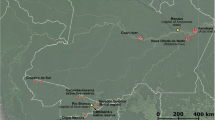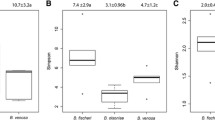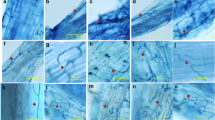Abstract
Endophytic fungi residing in Panax quinquefolium (American ginseng) have not been well characterized. We collected American ginseng of one-, two-, three- and four-year-old plants cultivated in a forest reserve and identified the endophytic fungal isolates using traditional methods. The colonization frequency and the dominant endophytic fungal species were investigated. Endophytic fungal diversity indices and similarity coefficient were also assessed and all age groups of American ginseng studied were colonized by endophytic fungal assemblages; 134 fungal isolates were assigned to 27 taxa. The infection frequencies varied with the host age and tissue. The dominant endophytic fungi were recorded for each tissue and age of host. The roots of two- and four-year-old American ginseng exhibited the highest and the lowest Shannon-Wiener index respectively. Four-year-old American ginseng had a low similarity coefficient when compared with each of the other three ages classes. The possible role of endophytic fungi in relation to American ginseng cultivation is discussed.
Similar content being viewed by others
References
Aly AH, Debbab A, Kjer J, Proksch P (2010) Fungal endophytes from higher plants: a prolific source of phytochemicals and other bioactive natural products. Fungal Divers 41:1–16
Ananda K, Sridhar KR (2002) Diversity of endophytic fungi in the roots of mangrove species on the west coast of India. Can J Microbiol 48:871–878
Arnold AE, Lutzoni F (2007) Diversity and host range of foliar fungal endophytes: are tropical leaves biodiversity hotspots? Ecology 88:541–549
Arnold AE, Mejia LC, Kyllo D, Rojas EI, Maynard Z, Robbins N, Herre EA (2003) Fungal endophytes limit pathogen damage in a tropical tree. Pro Natl Acad Sci U S A 100:15649–15654
Bettucci L, Saravay M (1993) Endophytic fungi of Eucalyptus globulus: a preliminary study. Mycol Res 97:679–682
Brundrett MC (2006) Understanding the roles of multifunctional mycorrhizal and endophytic fungi. In: Schulz BJE, Boyle CJC, Sieber TN (eds) Microbial root endophytes. Springer-Verlag, Berlin, pp 281–293
Clarke BB, White JFJ, Hurley RH, Torres MS, Sun S, Huff DR (2006) Endophyte-mediated suppression of dollar spot disease in fine fescues. Plant Dis 90:994–998
Fisher PJ, Petrini O (1990) A comparative study of fungal endophytes in xylem and bark of Alnus species in England and Switzerland. Mycol Res 94:313–319
Fisher PJ, Petrini LE, Sutton BC, Petrini O (1995) A study of fungal endophytes in leaves stems and roots of Gynoxis oleifolia Muchler (Compositae) from Ecuador. Nova Hedwig 60:89–594
Frohlich J, Hyde KD, Petrini O (2000) Endophytic fungi associated with palms. Mycol Res 104:1202–1212
Ganley RJ, Newcombe G (2006) Fungal endophytes in seeds and needles of Pinus monticola. Mycol Res 110:318–327
Gonthier P, Gennaro M, Nicolotti G (2006) Effects of water stress on the endophytic mycota of Quercus robur. Fungal Divers 21:69–80
Hata K, Futai K (1995) Endophytic fungi associated with healthy pine needles and needles infested by the pine needle gall midge, Thecodiplosis japonensis. Can J Bot 73:384–390
He CN, Gao WW, Yang JX, Bi W, Zhang XS, Zhao YJ (2009) Identification of autotoxic compounds from fibrous roots of Panax quinquefolium L. Plant Soil 318:63–72
Higgins KL, Arnold AE, Miadlikowska J, Sarvate SD, Lutzoni F (2007) Phylogenetic relationships, host affinity, and geographic structure of boreal and arctic endophytes from three major plant linages. Mol Phylogenet Evol 42:543–555
Huang WY, Cai YZ, Hyde KD, Corke H, Sun M (2008) Biodiversity of endophytic fungi associated with 29 traditional Chinese medicinal plants. Fungal Divers 33:61–75
Jumpponen A (2001) Dark septate endophytes—are they mycorrhizal? Mycorrhiza 11:207–211
Jumpponen A, Trappe JM (1998) Dark-septate root endophytes: a review of facultative biotrophic root-colonizing fungi. New Phytol 140:295–310
Krings M, Taylor TN, Hass H, Kerp H, Dotzler N, Hermsen EJ (2007) Fungal endophytes in a 400-million-yr-old land plant: infection pathways, spatial distribution, and host responses. New Phytol 174:648–657
Kumar DSS, Hyde KD (2004) Biodiversity and tissue-recurrence of endophytic fungi from Tripterygium wilfordii. Fungal Divers 17:69–90
Kumaresan V, Suryanarayanan TS (2001) Occurrence and distribution of endophytic fungi in a mangrove community. Mycol Res 105:1388–1391
Kumaresan V, Suryanarayanan TS (2002) Endophytes assemblages in young mature and senescent leaves of Rhizophora apiculata: evidence for the role of endophytes in mangrove litter degradation. Fungal Divers 9:81–91
Lacap DC, Hyde KD, Liew ECY (2003) An evaluation of the fungal ‘morphotype’ concept based on ribosomal DNA sequences. Fungal Divers 12:53–66
Magurran AE (1988) Ecological diversity and its measurement. Princeton University Press, Princeton
Megan S, Linda MK (2009) Evidence for alteration of fungal endophyte community assembly by host defense compounds. New Phytol 182:229–238
Postma J, Rattink H (1992) Biological control of Fusarium wilt of carnation with a non-pathogenic isolate of Fusarium oxysporum. Can J Bot 70:1199–1205
Raviraja NS (2005) Fungal endophytes in five medicinal plant species from Kudremukh Range, Western Ghats of India. J Basic Microbiol 45:230–235
Rodriguez RJ, White JJF, Arnold AE, Redman RS (2009) Fungal endophytes: diversity and functional roles. New Phytol 182:314–330
Rudgers JA, Holah J, Orr SP, Clay K (2007) Forest succession suppressed by an introduced plant-fungal symbiosis. Ecology 88:18–25
Schulz B, Boyle C (2005) The endophytic continuum. Mycol Res 109:661–686
Schulz B, Wanke U, Drager S, Aust HJ (1993) Endophytes from berbaceous plants and shrubs: effectiveness of surface sterilization methods. Mycol Res 97:1447–1450
Schulz B, Römmert AK, Dammann U, Aust HJ, Strack D (1999) The endophyte-host interactions: a balanced antagonism? Mycol Res 103:1275–1283
Sieber VT, Hugentobler C (1987) Endophytic fungi in leaves and twigs of healthy and diseased beech trees (Fagus sylvatica L.). Eur J For Pathol 17:411–425
Suryanarayanan TS, Vijaykrishna D (2001) Fungal endophytes of aerial roots of Ficus benghalensis. Fungal Divers 8:155–161
Taylor JE, Hyde KD, Jones EBG (1999) Endophytic fungi associated with the temperate palm, Trachycarpus fortunei, within and outside its natural geographic range. New Phytol 142:335–346
Tejesvi MV, Kini KR, Prakash HS, Subbiah V, Shetty HS (2007) Genetic diversity and antifungalactivity of species of Pestalotiopsis isolated as endophytes from medicinal plants. Fungal Divers 24:37–54
White JFJ, Cole GT (1985) Endophyte-host association in forage grasses. III. In vitro inhibition of fungi by Acremonium coenophialum. Mycologia 77:487–489
Zhang HW, Song YC, Tan RX (2006) Biology and chemistry of endophytes. Nat Prod Rep 23:753–771
Zhao YJ, Wang YP, Shao D, Yang JS, Liu D (2005) Autotoxicity of Panax quinquefolium L. Allelophathy J 15:67–74
Acknowledgments
This work was supported by National Key Technology R&D Program in the 11th Five Year Plan of China (2006BAI09B03-1). The authors thank Professor John Klironomos (University of British Columbia-Okanagan, Canada) for valuable comments and suggestions on improving the manuscript.
Author information
Authors and Affiliations
Corresponding author
Rights and permissions
About this article
Cite this article
Xing, X., Guo, S. & Fu, J. Biodiversity and distribution of endophytic fungi associated with Panax quinquefolium L. cultivated in a forest reserve. Symbiosis 51, 161–166 (2010). https://doi.org/10.1007/s13199-010-0062-6
Received:
Accepted:
Published:
Issue Date:
DOI: https://doi.org/10.1007/s13199-010-0062-6




